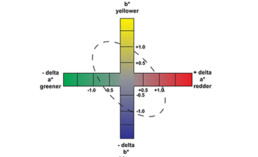Defining Color Tolerances
The end goal of implementing a color process is to get the color you want, or your customer wants, for the finished product through an efficient and streamlined process. If the color of a product doesn’t match the standard, customer satisfaction is compromised and the amount of rework, waste, and costs increase. Establishing color tolerances objectively within the color process is an effective way to maintain color consistency and accuracy, as well as to meet standards more efficiently.
A color tolerance is a limit to how big the difference in color between a sample and the standard is allowed to be for the sample to be considered acceptable. Using color measurement instrumentation, tolerance values should be defined internally or between supplier and customer, and used in quality control to determine if the sample passes or fails inspection. To establish a color tolerance, the below steps should be followed.
1. Define a Color Standard: What Color Do You Want the Finished Product to Be?
A standard should be defined internally or between supplier and customer. Using color measurement instrumentation, measure the color you would like to match for the finished product and record its color values.
2. Perform Visual Assessments: What Colors are Visually Acceptable?
Visual assessments are performed to correlate human visual perception with the numerical values of color. To begin, gather samples or color batches that appear similar in color to the standard and visually assess them using a light booth. Select the colors that are visually different from the standard but are still considered an acceptable match to the standard. Once the visual assessments are complete, gather the samples for measurement.
Please note, the sensitivity of the human eye varies from person to person, which may cause color to appear differently to each individual. Therefore, it is recommended to use a committee of people to confirm these visual assessments and maintain consistency.
3. Define Tolerance Values: What is the Range for Acceptability?
Take measurements of each sample chosen from the visual assessments using a colorimeter or spectrophotometer. The difference in color between each sample and the standard should be recorded as ΔL*,
Δa*, Δb*, ΔC*, ΔH*, and ΔE*, depending on the color space being used. The sample color with the values furthest from the standard color can be used as the maximum tolerance limit.
Please note, these values should be reevaluated throughout the manufacturing process and continuously refined to identify the ideal tolerance values for your application.
4. Establish a Tolerance System: Rectangular, Circular, or Elliptical?
Tolerance values should correlate to the human eye so that color is both visually and numerically acceptable. This ensures consistency from one batch of material to the next. For this, it is recommended to use an elliptical tolerance system, such as CIE2000, because these systems are based on the color discrimination threshold of the human eye. Elliptical tolerance systems were established to address the weaknesses of other tolerance systems and improve accuracy. The maximum limit tolerance values defined in Step #3 form an ellipsoid around the standard color. Color that falls inside the defined tolerance ellipsoid is considered acceptable, while color that falls outside of this ellipsoid is rejected.
High-accuracy color measurement instrumentation and color analysis software, such as SpectraMagic NX2, make it easier to define tolerance values and identify inconsistencies between a sample color and the standard. Want to learn more about color measurement? Join us for a two-part webinar series this May (2022) about the essentials of color science and the elements of an effective color process within research and manufacturing environments.










